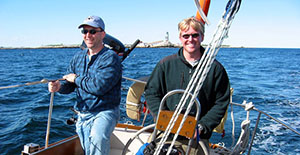Support the sailing program!
Reserve the Pavilion
Upcoming Events
Tue 6 January
Thu 8 January
Tue 13 January
Thu 15 January
Tue 20 January
Latest Results

Bluewater Skipper Rating
The first step to becoming a skipper is to start sailing! You must become very familiar with the boat and how to sail her. If you're new to coastal sailing, there is much to learn and the best place to learn is out on the water. Sign up for trips and let your captains know that you're interested in becoming a skipper. They may assign you various responsibilities on the trip.
The next step is to start helping maintain the boat. Get familiar with the systems on board and do your part to help keep her in good shape. Although the list of maintenance tasks may appear daunting, there is most certainly some way in which you can contribute.
When not out on the water, you can learn quite a bit about coastal sailing by getting yourself a good book on the subject. We recommend the following excellent texts:
- Chapman Piloting & Seamanship
- The Annapolis Book of Seamanship
If you already have experience sailing boats the size of X Dimension, then the process of becoming a skipper will likely be much quicker.
Skipper Requirements
To become an MIT bluewater skipper, you must:
- obtain the Provisional, Crew, and Helmsman ratings
- illustrate your comprehension of the X Dimension ship systems
- illustrate your mastery of ocean sailing skills
- demonstrate your ability to direct a crew
- actively participate in the maintenance, upkeep, and improvement of the boat
- participate in at least two skipper training cruises
- teach at least one sailing class session at the pavilion each season
- obtain approval from two other bluewater skippers by acting as captain on X Dimension trips with them
- complete a US Coast Guard course such as OUPV (6-pack) or master license or ASA chartering course
- be approved by the MIT Sailing Master
Bluewater Sailing Skills
Some of the skills that you need to master as a bluewater skipper include:
- sailing onto and off of a mooring
- proper use of lines when docking
- proper use of winches and general line handling
- understanding of mainsail and genoa trim, including proper use of sheets, traveler, vang, etc.
- sail reefing techniques
- anchoring skills
- reading nautical charts
- navigation techniques, such as dead reckoning and determining a fix
- identification of bouys, lights, daybeacons, and other aids to navigation
- understanding of tides
- proper use of the ship's compass
- proper use of GPS
- proper use of Radar
- VHF radio protocols
- proper use of the diesel engine
- knowledge of distress signals and other emergency procedures
- comprehensive knowledge of U.S. and international Navigation Rules.
- understanding of state and federal boating laws
- and many others...
